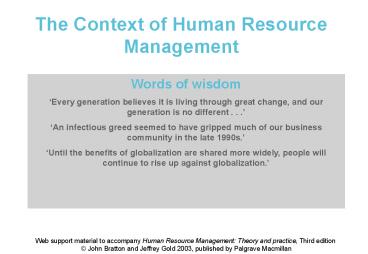Bratton & Gold: HRM 3e CHAPTER 2 - PowerPoint PPT Presentation
1 / 23
Title:
Bratton & Gold: HRM 3e CHAPTER 2
Description:
The content of these s is copyrigh protected. Material is for use only within lectures and cannot be copied or reproduced without permission. – PowerPoint PPT presentation
Number of Views:156
Avg rating:3.0/5.0
Title: Bratton & Gold: HRM 3e CHAPTER 2
1
Title
The Context of Human Resource Management
Words of wisdom Every generation believes it is
living through great change, and our generation
is no different . . . An infectious greed
seemed to have gripped much of our business
community in the late 1990s. Until the benefits
of globalization are shared more widely, people
will continue to rise up against globalization.
2
Chapter outline
The Context of Human Resource Management
3
Conceptions of Contexts
The Context of Human Resource Management
Conceptions of contexts An open system a set
of interrelated and interdependent parts
configured in a manner that produces a unified
whole. Work organizations acquire inputs from the
environment, transform them and discharge outputs
to the external environment.
4
Figure 3.1 An open system
Conceptions of contexts
5
Figure 3.2 A model of the external contexts of HRM
Conceptions of contexts
6
The economic context
The Economic Context
Globalization The growing integration of the
worlds economies. Core economic activities are
conducted on a global scale. The communications
revolution. Fundamental political change.
7
Table 3.1 Per capita income growth in selected
developed countries, 1960-96
The Economic Context
8
Fig 3.3 Growth in domestic product in the EU for
the 3rd quarter of 2001 and 2000
The Economic Context
9
Fig 3.4 Unemployment in Britain, 1960-2000
The Economic Context
10
Fig 3.5 One view of the labour market
The Economic Context
11
Table 3.2 Non-regular forms of employment,
selected countries, 1973-93
The Economic Context
12
Table 3.3 Composition of the UK workforce, 1980
and 1998
The Economic Context
13
The technology context
The Technology Context
Technological change Advanced technical
change. Conventional technical change. Organizatio
nal change.
14
Table 3.4 Diffusion of microtechnology in UK
workplaces, 1984-1998
The Technology Context
15
The political context
The Political Context
The state Is responsible for economic policy
that influences labour markets. Establishes the
legal context of employment relations. Is an
employer in its own right.
16
The political context
The Political Context
State interventions Facilitative Supportive Direc
tive Neoliberalist
17
Table 3.5 Key UK employment legislation, 1961-2002
The Political Context
18
The social context
The Social Context
Changing demographic determine the size and
composition of the workforce. Different attitudes
and values relating to work, parenthood, leisure,
fairness, organizational loyalty.
19
Fig 3.6 An ageing population working less
The Social Context
20
Fig 3.7 The work-life balance
The Social Context
21
Change HRM
Change and HRM
What are the implications of economic and
technological changes for the recipients of
HRM? Depends on whether you are a core (see
empowerment and high rewards) or peripheral
(see employment insecurity) employee. Employment
standards tend towards worst rather than best
practice.
22
Chapter summary (1st half)
23
Chapter summary (2nd half)































